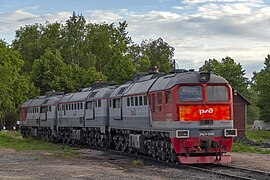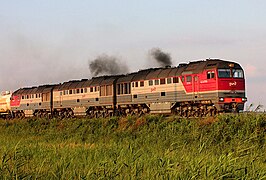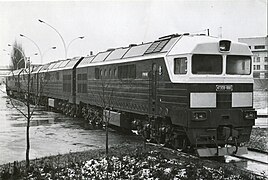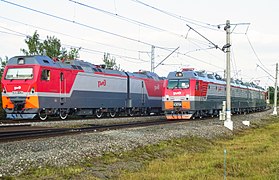B–unit
This article has multiple issues.Please helpimprove itor discuss these issues on thetalk page.(Learn how and when to remove these template messages)
|



AB unit,inrailroad terminology,is alocomotiveunit (generally adiesel locomotive) which does not have a controlcabor crew compartment, and must therefore be operated in tandem with anothercoupledlocomotive with a cab (anA unit). The termsbooster unitandcablessare also used. The concept is largely confined toNorth Americaand post-Soviet countries. Elsewhere, locomotives without driving cabs are rare.
The term primarily is applied to freight locomotives, but can be applied to passenger multiple units as well in some cases for when motor cars are put in the middle of trains. In practice however, the term is rarely used to describe multiple unit trains, and in many circumstances the non-cab cars are directly or indirectly permanently attached to a cab car.
Controls[edit]
Some B units cannot be moved without a controlling unit attached, but most have some simple controls inside, and often a side window at that control station. For example, B unit versions of theEMD FTwith conventional couplers had a fifth porthole-style window added on the right side only for the control station. Other models used existing windows. These controls enable ahostlerto move the B unit locomotive by itself in a yard or shops. B units without controls are generally semi-permanently coupled to controlling units. Sometimes, there is a terminology distinction between the types: a 'booster' is a B unit with hostler controls, and a 'slave' is a B unit without hostler controls.
Reasons for use[edit]
The reasons railroads ordered B units included the fact that a B unit was slightly cheaper. With no driving cab, B units lack windshields, crew seats, radios, heating, and air conditioning. There would also be no toilets, which were usually found in the short hood of an A unit. Additionally, at first, railroads bought multiple-unit diesel locomotives as one-for-one replacements for steam locomotives; as a result, railroads could not take advantage of the flexibility afforded by interchangeable units, which could be assembled into any required power output. When a three- or four-unit locomotive was considered an indivisible unit, there was no point in the intermediate units having cabs. A further advantage was that as B units had no controls, unions were unable to insist that each unit be staffed. Finally, B units gave a smoother, streamlined appearance to the train for passenger service.
The B unit era[edit]
B units were commonly built in thecab unitdays in the 1930s, 1940s, 1950s and 1960s. Whenhood unitroad switchersbecame the common kind of diesel locomotive, some B units were built, but many railroads soon came to the opinion that the lower cost of a B unit did not offset the lack of operational flexibility. Few B units have been built in the last 40 years. Railroads that kept ordering B units longer than most were largely Western roads, including theSouthern Pacific,Union Pacific,Burlington Northernand theSanta Fe.Santa Fe ordered theGP60Bmodel in 1991, which were the final B units built for road service in North America as of 2005.
Conversions[edit]
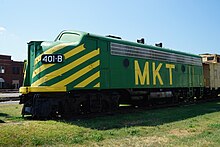
In some cases, a B unit is converted from an already existing A unit. The cab is either removed or has its windows blanked out (such as onCSXGE BQ23-7units), and all non-essential equipment is removed. The degree to which this equipment is removed depends on the railroad, but may (and usually does) include the removal of the speedometer, event recorder, horn, headlights, toilet, and cab heaters. This conversion was sometimes performed when the A unit had been in a collision and rebuilding the cab was not cost-effective.
In some rare instances, B units were converted to incorporate a cab, such as on theChicago & North Western Railwayin the 1970s with someEMD E8B units bought from theUnion Pacific.The homebuilt cabs were referred to as "Crandall Cabs". Also, the Santa Fe rebuilt four of its fiveGP7Bsto GP9us with cabs. In theIllinois Central Gulf's GP11 rebuild program, some of the engines used were ex-UP GP9Bs, and in their SD20 program, some ex-UP SD24Bs were also used. BNSF converted a former ATSF GP60B #370 into a cab unit and was renumbered to #170 in 2010. This unit was later renumbered as BNSF 200 in 2014.
Unusual consists[edit]
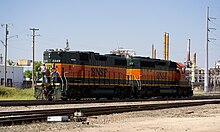
In rare instances, a B unit will run at the front of a train. That is usually avoided because it limits visibility from the locomotive cab, but locomotive orientation and operational requirements may dictate that the B–unit runs first.[1][2][3]A prominent example is theHaysi Railroad,which owned an F7B that was given radio controls and a makeshift cab.
List of B unit locomotive models[edit]
These are all known B unit models, with discrepancies settled by the later (Marre) reference. At least one of each model was manufactured. All units below contain one or more engines and traction motors, soslugsandsnailsare not listed.
United States[edit]



In the US, B units of mainline diesel locomotives usually had their own model designation and received their individual numbers as independent locomotive units, not tied to any A units. The first B units usually used next or previous model number to model number of a corresponding A unit (for example, ALCO DL-202 and DL-203 for A and B units respectively), later the model name was usually indicated by the letter B at the end or in the middle of a model. The only exception is the DD35, which was initially created as B unit before a similar A unit with a cabin, called DD35A, appeared. At the same time, shuntingcow-calfdiesel locomotives with semi-permanently coupled A and B unit were considered a single locomotive, so a common designation for both units were used. The New York City Revenue cars 66 and 67 were R8A units which were B units also.
Diesel locomotives:
- Factory-built:
- ALCO/MLW—Black Maria Booster,DL-108,DL-110,FB-1,FB-2,FPB-2,FPB-4,PB-1,PB-2,C855B,M420B
- Baldwin—AS-616B,DRS-6-6-1500B,DR-4-4-15B,RF-16B,DR-6-4-15B,DR-6-4-20B
- EMD E units—EB,E1B,E2B,E3B,E4B,E5B,E6B,E7B,E8B,E9B
- EMD F-units—FTB,F2B,F3B,F7B,F9B
- EMDHood units–DD35,GP7B,GP9B,GP30B,GP60B,SD24B
- Fairbanks-Morse—B Erie,CFB-16-4,CFB-20-4,CPB-16-4,CPB-16-5
- GE Transportation—UM20B booster,B30-7A
- Rebuilds:
- Power carlocomotives for diesel trainsets
- Budd Company— power cars 9906B and 9907B ofDenver Zephyrtrainsets (A-B formation)
- Pullman-Standard— power cars forM-10002andM-10003 to M-10006trainset (A-B or A-B-B formation)

Gas turbine locomotives:
- Factory-built:
- ALCO/GE Transportation-Union Pacific gas turbine locomotivesof the third generation with a diesel A and gas turbine B unit
- Rebuilds:

USSR, Russia, Ukraine and other post-Soviet countries[edit]
In the USSR and later Russia, Ukraine, Kazakhstan and other post-Soviet countries, unlike the US, B units don't have their own numbers and model designations, because they operate in a semi-fixed formations with two A units and so considered as parts of a single multi-unit locomotive with A-B-A or A-B-B-A configuration respectively. Most of these locomotives work onBAMrail line, located onRussian Far East.Many other Russian locomotives function as semi-permanently coupled 3 or 4 unit sets.
A prefix number with the total number of units is indicated in the model name before the main designation: «2» was used for two-unit A-A locomotives, «3» — for three-unit A-B-A locomotives and «4» — for four-unit A-B-B-A locomotives. Each unit has an additional letter after a number: letters «А» and «Б» («A» and «B») are given to two A units, and letters «В» and «Г» («V» and «G», third and fourth letters in Russian alphabet) are given to B units in the middle. The only exception are electric locomotives 2ES10, B units of which received separate numbering and the «2ЭС10С» (2ES10S) type designation. In the factory documentation, the three-unit version of these locomotives often called as 3ES10, however, this designation is not used in practice.
At the same time, the designation system of industrial quarry electric and electro-diesel locomotives is different. The number initially indicated the number of motorized dump cars orslugs,and the letter A or T indicated the presence of a diesel generator B unit, but subsequently the numbers and letters lost their original meaning.
Diesel locomotives:
- Luhanskteplovoz(Ukraine) —3TE3,3TE10(3TE10V, 3TE10M, 3TE10U, UzTE16M3 and 4TE10S),3M62U,4TE130,3TE116U
- Bryansk Machine-Building Plant(Russia) —3TE25K2M,3TE25K3M,3TE28.
B–units of these locomotives have reduced set of driving controls, intended for service movement of the locomotive.
- Russian and Ukrainian multi-unit diesel locomotives
-
3M62U
-
3TE116U
-
4TE130
-
3TE25K2M
Electric locomotives:
- Novocherkassk Electric Locomotive Plant(Russia) —3ES5K / 4ES5K,3ES4K,3ES5S
- some A units ofVL80S electric locomotives have been converted into B units
- Ural Locomotives(Russia) —3ES6,3ES8,3ES10
Industrial electro-diesel locomotives:
- Dnipro Electric Locomotive Plant(Ukraine) —OPE1A,OPE1B,PE3T(versions with diesel-generator B–unit instead of one or both motorized dump cars)
- Russian and Ukrainian multi-unit electric locomotives
-
3ES4K locomotive has pantographs on all three units, including a B unit
-
3ES10 (officially 2ES10 with 2ES10S B–unit) and 4ES5K electric locomotives have pantographs only on A units
-
3ES8 electric locomotives has pantographs only on A units
-
OPE1A electro-diesel locomotive with primary electric locomotive (A unit), diesel-generator booster (B unit) and motorizeddump car
Australia[edit]

- 4Australian NationalBUs, rebuilt fromSouth Australian Railways 600 classbyMorrison Knudsen,Whyallain 1994[4]
- 3CM40-8ML- cabless version ofC40-8built onC636frames forBHPin 1994[5]
- 3Pacific National XRB classbuilt in 2005/06[6]
Italy[edit]
- Class E.322andClass E.324electric locomotives (without cab and alsopantograph).
United Kingdom[edit]
- British Rail Class 13were diesel shunting locomotives with two semi-permanently coupled A and B units, both converted fromBritish Rail Class 08[7]
Sweden[edit]
- Dm3three-unit electric locomotives with A-B-A formation (originally they were two-unit Dm locomotives and later B units were coupled in the middle)
-
British Rail Class 13diesel locomotive with a master A and slave B unit, the United Kingdom
-
Italian electric locomotive E.321.111 (A unit) coupled with E.322.111 (B unit), Italy
-
Dm3three-unit electric locomotive, Sweden
Belgium[edit]
NMBS/SNCB,the national railway company ofBelgiumused to operate one locomotive which could be considered a B–unit. Originally a regular Type 82 shunting locomotive, locomotive 8275 had the top half of its control cab removed. Type 82 locomotives were mostly used in pairs for shunting heavy freight trains. Because of visibility issues, the engineer would have to get from one locomotive to the other with every direction change. In 1975, the railway company, seeking a solution for this problem, decided to adapt part of their Type 82 fleet. For testing purposes, 8275 had most of its cab removed, including the windows, the doors and the roof. The basic controls were left in place, covered by a removable metal plate, so it would be possible to control the locomotive on its own in case of emergency. With the cab removed, the engineer could see over the B–unit, so getting from one locomotive to the other was no longer necessary.
After extensive testing proved that the adaptions were unsuccessful, it was decided that no other units would be converted. However, 8275 was never converted back and served as Belgium's only B–unit, mostly in the port of Antwerp, until 2001, when it was scrapped after a collision with a truck. 8275 and the locomotive it was connected to were known as 'Koe en Kalf' (cow and calf) among railway staff.
China[edit]
Electric locomotives:
- HXD1electric locomotives for coal railways ofShenhua Groupmay have one or four B units. In 2013, CSR delivered 2 three unit locomotives (A-B-A formation, 14.4 MW).[8]In 2020, CRRC produced six-unit locomotives (A-B-B-B-B-A formation, 28.8 MW) forChina Energy Investmentthe parent holding company ofShenhua Group.[9][10]With a power output of 28.8 MW it is regarded as the world's most powerful multi-segment electric locomotive.[11][12]These locomotives are dubbed the "Shenhua 24" Series.[13]
Electro-diesel trainsets:
- FXN3-J diesel-electric locomotive with A and B units, derived from a FXN3 locomotive with two A units, manufactured byCRRC Dalian.This locomotive operates as a power car of a push-pullCR200JS-GFuxing electro-diesel trainset with HXD1D-J electric locomotive and 9 passenger coaches. Both electric and diesel-electric lcoomotives have changed body design and are adapted for joint operation as part of a train.[14][15]These trains are served onSichuan–Tibet railway.[16]
References[edit]
- ^"Long hood forward, yet".Archivedfrom the original on 2005-04-18.Retrieved2021-02-23.
- ^"RailPictures.Net Photo: UP 726B Union Pacific EMD GP30B at San Bernardino, California by Craig Walker".Archivedfrom the original on 2021-12-31.Retrieved2021-02-23.
- ^http://www.rrpicturearchives.net/showPicture.aspx?id=238466Archived2007-03-12 at theWayback MachineGP35/GP9B
- ^BU - Booster Units in TrafficCatch Pointissue 104 November 1994 page 8
- ^Rolling Stock NewsAustralian Railway Historical Society Bulletinissue 761 March 2001 page 112
- ^XRB Class LocomotivePacific National
- ^New British Railways Standard ShunterDiesel Railway TractionMay 1955 pages 142-146
- ^Thần hoa tân hình bát trục đại công suất giao lưu điện lực cơ xa thượng tuyến thí vận hành. Quốc vụ viện quốc tư ủy. 2013-01-17 [2013-01-15].
- ^Hoàng hà lưu."Toàn cầu tối đại công suất điện lực cơ xa thần 24 tạc tại chu hạ tuyến".cn.chinadaily.com.cn.Retrieved2021-03-28.
- ^"Thần sóc thiết lộ, 24 trục điện lực cơ xa, lệ hại, lệ hại".xw.qq.com(in Chinese).Retrieved2021-03-28.
- ^"Toàn cầu tối đại công suất điện lực cơ xa thần 24 tại trung xa chu cơ hạ tuyến _ trọng tái".www.sohu.com.Retrieved2021-03-28.
- ^"28·8 MW freight locomotive unveiled".Railway Gazette International.2020-08-04.Retrieved2021-03-28.
- ^"China develops high-power electric locomotive-Ecns.cn".ECNS.Retrieved2021-03-28.
- ^"CR200JS-G".china-emu.cn(in Chinese).
- ^"CR200JS-G (video)".bilibili.com.
- ^"Tần lĩnh sơn gian vũ tiểu thanh —— nội điện song nguyên cao nguyên động xa tổ bảo thiên thiết lộ tinh thải lượng tương".sohu.com(in Chinese). 14 May 2021.Retrieved13 April2022.
- Marre, Louis A. (1995).Diesel Locomotives: The First 50 Years.Kalmbach Publishing Co.ISBN0-89024-258-5.
- Pinkepank, Jerry A. (1973).The Second Diesel Spotter's Guide.Kalmbach Books. Library of Congress Catalog Card No. 66-22894.

